Physical Address
304 North Cardinal St.
Dorchester Center, MA 02124
Physical Address
304 North Cardinal St.
Dorchester Center, MA 02124
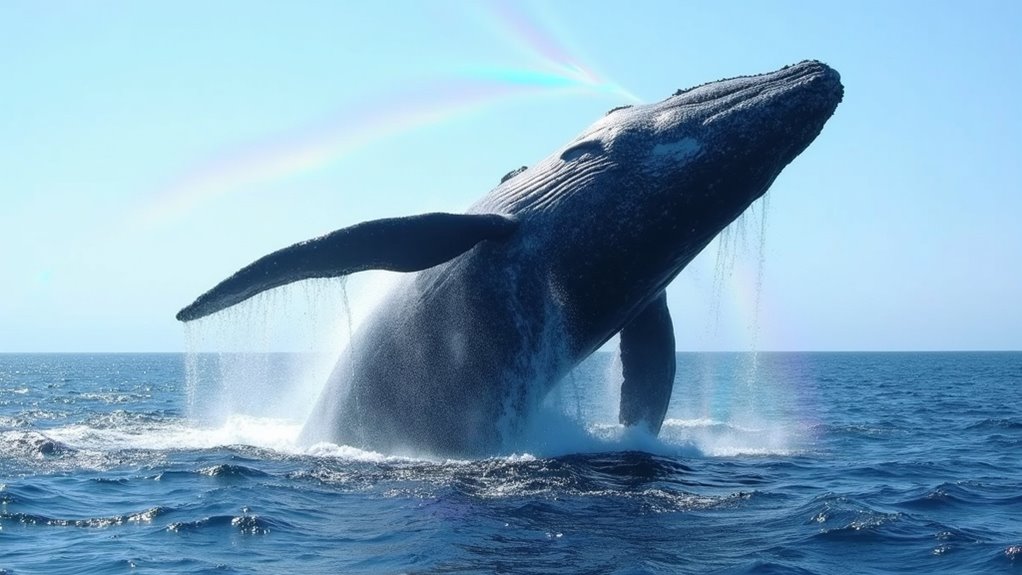
Behold the planet's most colossal creatures, from blue whales to mammoth salamanders—their sheer size will leave you speechless.
Earth’s most massive creatures span oceans, land, and ancient lineages. You’ll encounter the 110-foot blue whale weighing 440,000 pounds, African elephants reaching 15,000 pounds, and mysterious colossal squids at 500kg. The lineup includes whale sharks, saltwater crocodiles, giraffes, ostriches, green anacondas, and critically endangered giant Chinese salamanders. Each giant boasts unique adaptations for survival and plays vital ecological roles in their respective habitats. Discover how these remarkable behemoths navigate our planet against increasing threats.
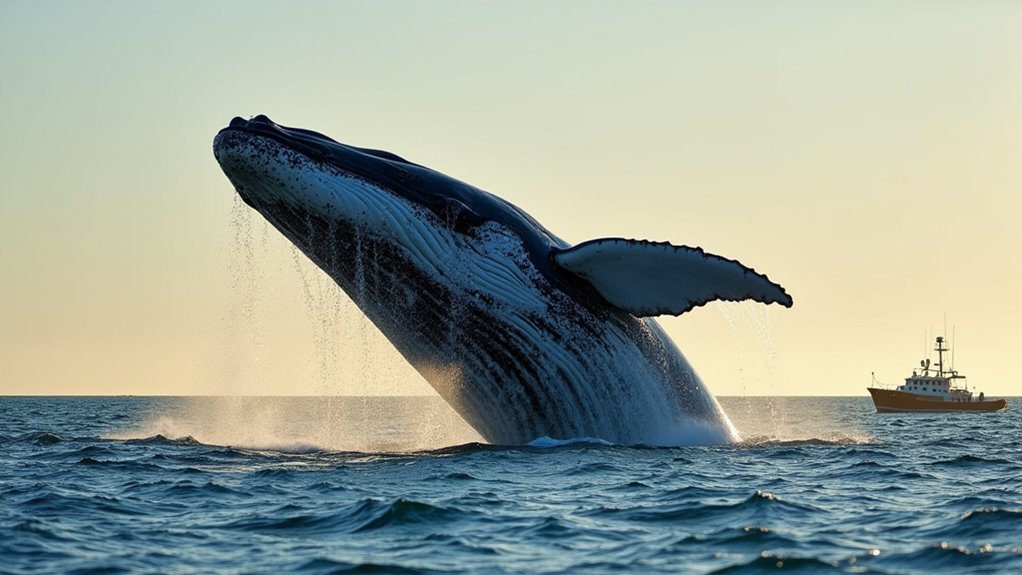
The blue whale stands as the largest animal ever known to have existed on Earth, dwarfing even the mightiest dinosaurs that once roamed the land. These marine giants reach up to 110 feet in length and can weigh as much as 440,000 pounds—with females typically larger than males.
Colossal leviathans of the deep, blue whales outsize even history’s greatest dinosaurs with their breathtaking scale.
You’ll find their slender bodies sporting a mottled blue-gray coloration that appears light blue underwater. Each whale has unique markings that help researchers identify individuals. Their underbellies sometimes appear yellowish due to diatom coating, earning them the nickname “sulphur bottom whales.”
Though massive, they’re surprisingly fast, cruising at 5 mph but capable of 20 mph bursts. Their vocalizations are among the loudest in the animal kingdom, traveling up to 1,000 miles underwater.
Despite protection efforts, they remain endangered, threatened by fishing gear entanglement, ocean noise, and ship strikes.
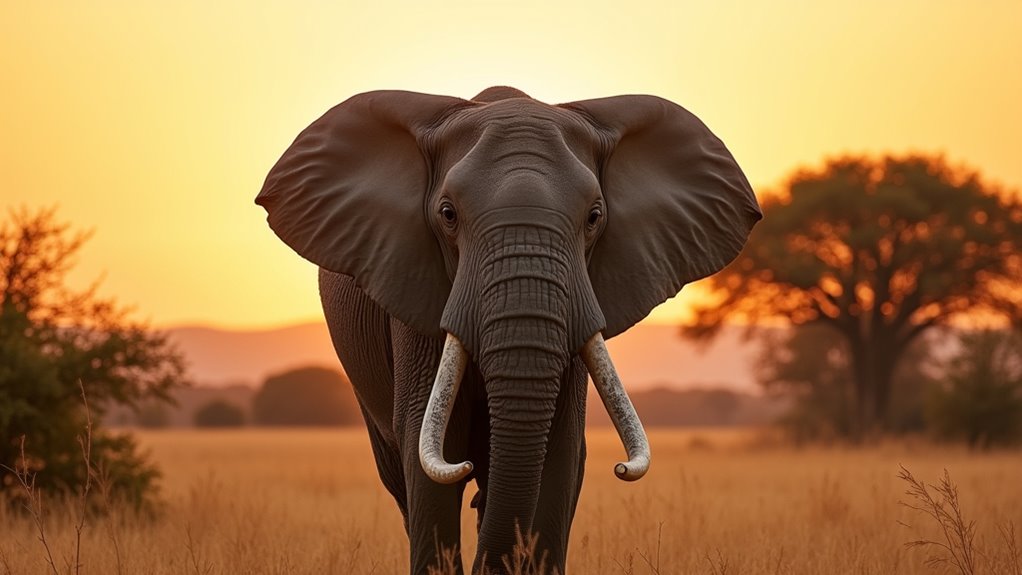
Standing as the largest land animals on Earth, African elephants dominate the savannas and forests across sub-Saharan Africa with their imposing presence. Males of the larger bush elephant species can reach shoulder heights of 11 feet and weigh over 15,000 pounds, dwarfing their forest-dwelling cousins.
You’ll recognize these magnificent creatures by their curved tusks, massive triangular ears, and distinctively wrinkled gray skin. The two species—bush and forest elephants—differ noticeably in size and back shape, with bush elephants featuring a concave back.
Beyond their physical grandeur, these highly social animals exhibit remarkable intelligence and emotional complexity. These giants possess a highly convoluted neocortex with a neuron count comparable to humans, enabling their impressive cognitive abilities.
Unfortunately, they face serious threats from poaching and habitat loss, endangering their vital role as ecosystem engineers that enhance biodiversity through their daily activities.
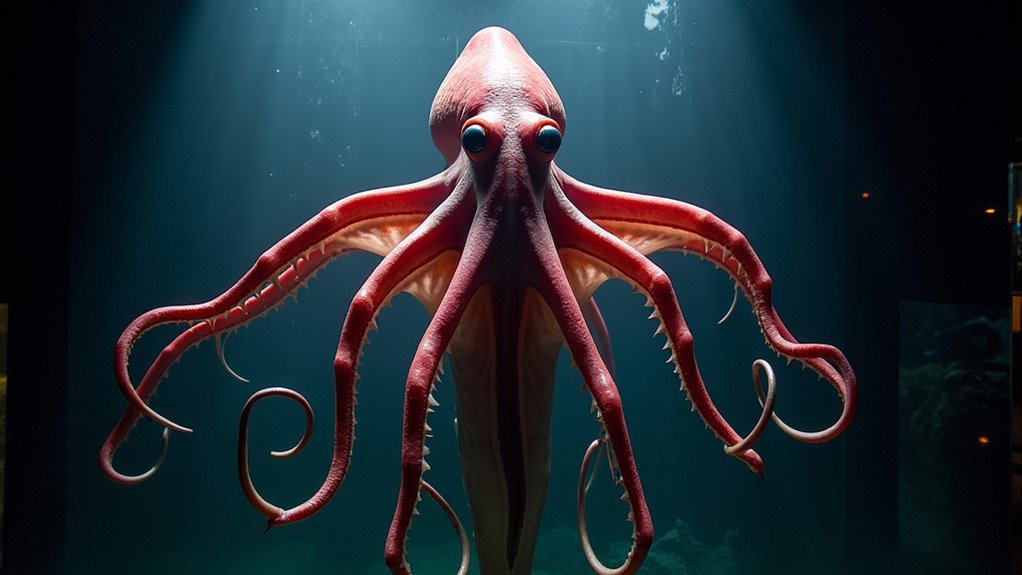
Deep within the frigid waters surrounding Antarctica dwells one of Earth’s most elusive giants—the colossal squid. These massive invertebrates can reach lengths of 6-7 meters and weigh over 500 kilograms, comparable to a small fire truck.
Hidden in Antarctic depths lurks the colossal squid—a massive invertebrate reaching sizes comparable to a small fire truck.
You’ll find these creatures in the mesopelagic to bathypelagic zones, typically at depths exceeding 1,000 meters. Juveniles display a transparent, glass-like appearance before maturing into their dark red or purple adult form.
As ambush predators, colossal squids use hook-lined tentacles to capture deep-sea fish and other squids. Their fierce battles with sperm whales often leave distinctive scars on the whales, testifying to the squid’s formidable defensive capabilities. They’re hunted by sperm whales and sleeper sharks, with toothfish occasionally scavenging their remains.
Until 2025, scientists had never recorded live footage of these mysterious creatures, making recent discoveries particularly significant for understanding their behavior and lifecycle.
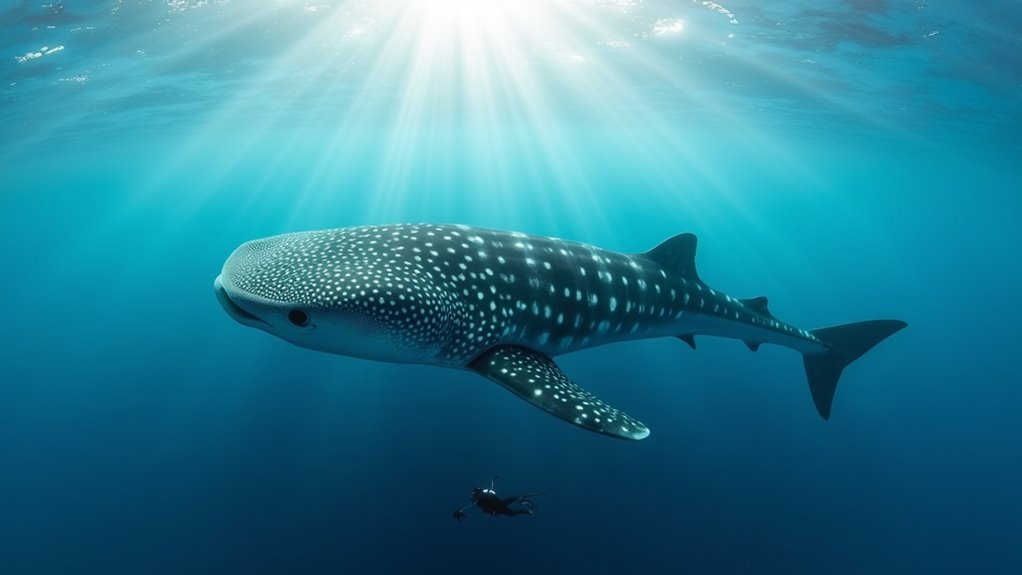
While colossal squids lurk in the ocean’s darkness, whale sharks dominate the sunlit surface waters as the planet’s largest fish species. These endangered giants can reach 18 meters in length and weigh up to 26,000 pounds.
You’ll recognize whale sharks by their distinctive white-spotted pattern and massive, filter-feeding mouths. Despite their intimidating size, they’re harmless plankton eaters that cruise warm tropical waters between 21°C to 25°C.
These gentle behemoths travel vast distances seeking nutrient-rich upwellings, sometimes diving to depths of 1,000 meters. Their unique skin, with a thickness exceeding 100 mm thick, provides protection and may shield against UV radiation. They often gather in large numbers where food is abundant.
Females give birth to live young and typically grow larger than males. Though protected in many countries, whale sharks face declining populations, serving as important indicators of ocean health.
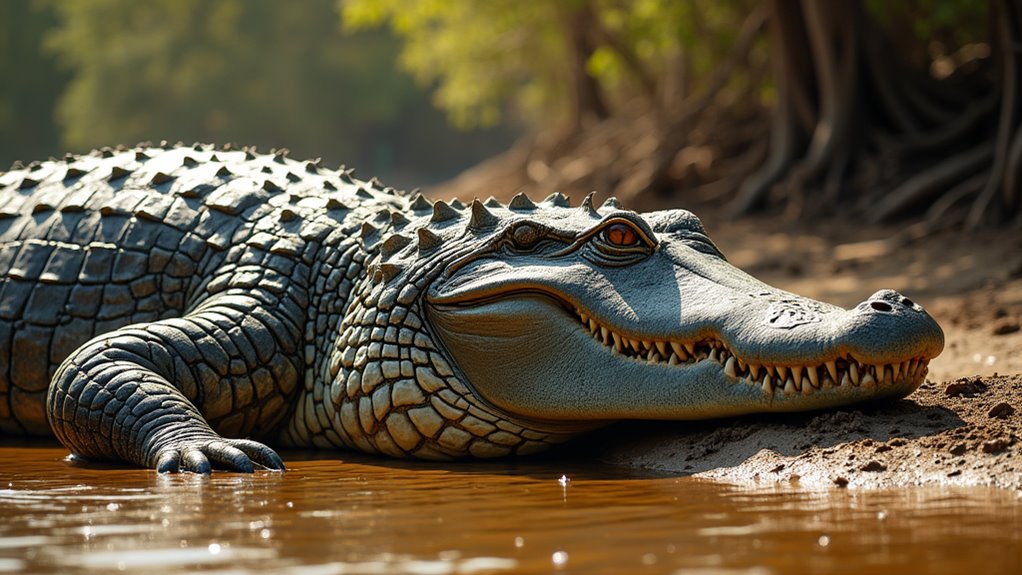
Among the world’s most formidable predators, saltwater crocodiles reign as the planet’s largest reptiles, with males reaching an impressive 6-7 meters in length and weighing up to 1,200 kg.
You’ll find these ancient beasts in brackish and freshwater regions across Eastern India, Southeast Asia, and Northern Australia. These highly intelligent reptiles employ sophisticated thermoregulation techniques, alternating between cooling in water and basking in the sun to maintain optimal body temperature.
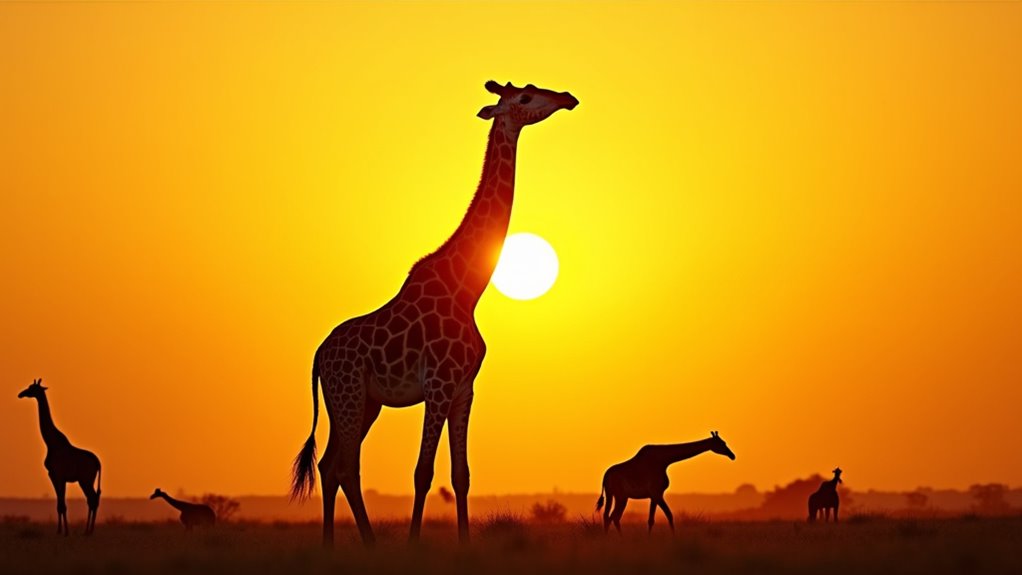
Standing majestically on the African plains, giraffes claim the title of tallest terrestrial mammals on Earth, with males reaching impressive heights of up to 5.5 meters. These giants weigh in at approximately 1,192 kg for males and 828 kg for females.
Despite their enormous stature, you’ll notice each giraffe displays a unique coat pattern of dark blotches surrounded by light hair, providing effective camouflage in savannah woodlands. Their distinctive pattern isn’t just for show—it contains specialized blood vessels and sweat glands that help regulate body temperature. The coat pattern remains consistent throughout their lifetime, though males experience darkening of blotches with age, sometimes turning from brown to coal-black.
Their remarkable necks, containing just seven elongated vertebrae, serve multiple functions: reaching high foliage, spotting predators, and engaging in dominance battles.
To overcome gravity’s challenges, giraffes have evolved a powerful circulatory system that efficiently pumps blood up their long necks to their brains.
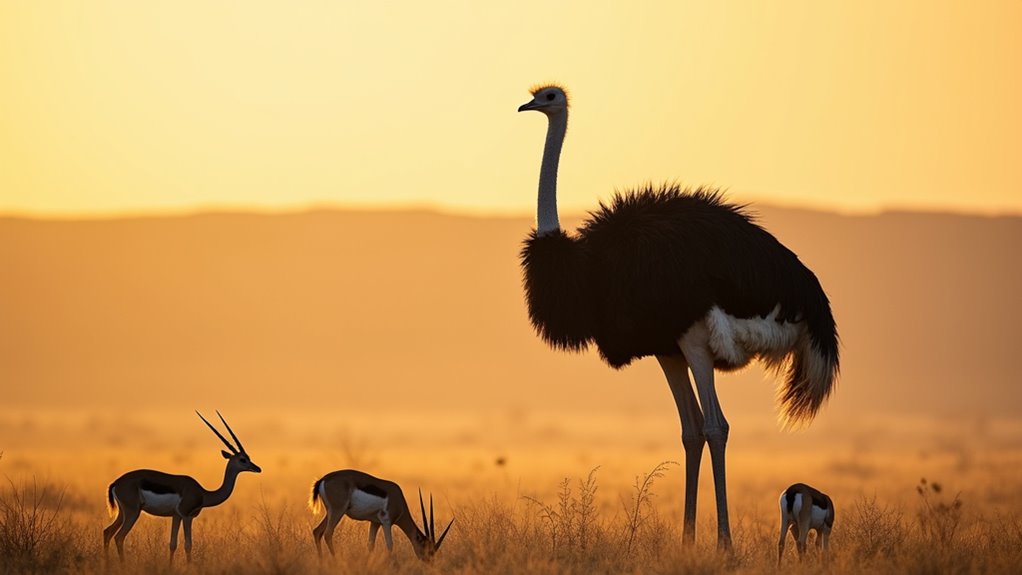
Towering above all other avian species, ostriches reign as the largest birds on Earth, with adult males stretching up to 2.75 meters tall and weighing more than 150 kg. These remarkable creatures are native to Africa’s savannahs and grasslands, where they’ve adapted perfectly to hot, arid environments. Their distinctive feet have only two toes with one bearing a sharp 10 cm claw used for defense.
You’ll find two main species: the Common Ostrich and the Somali Ostrich, with several subspecies displaying different physical traits.
Despite their massive size, they’re incredibly swift runners, reaching speeds of 70 km/h on their powerful legs.
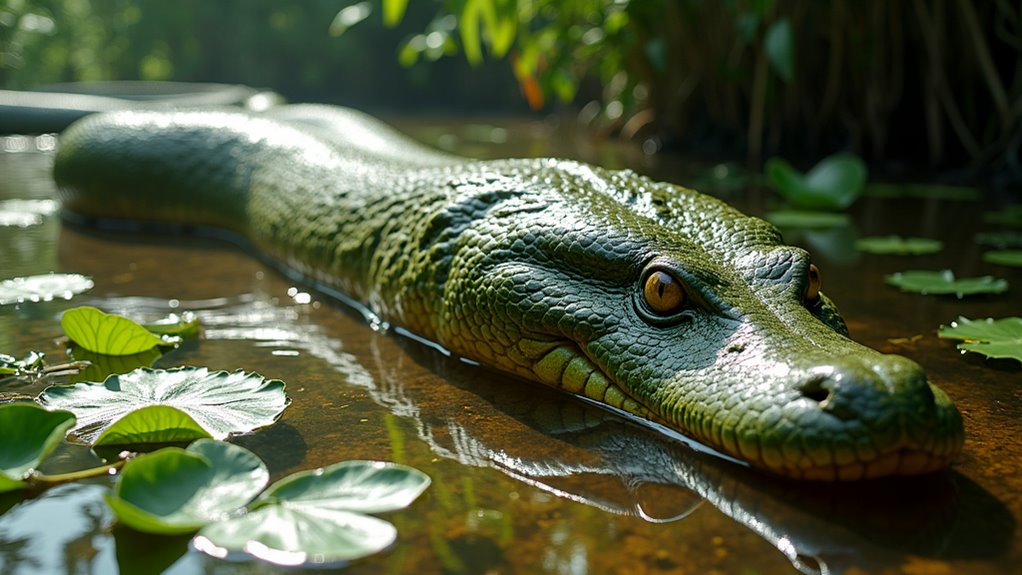
Green anacondas claim the title of the world’s heaviest snakes, sliding into our examination of Earth’s most massive creatures with their impressive bulk. These South American giants can reach 30 feet in length and weigh over 550 pounds, with females growing up to five times larger than males.
You’ll find these semiaquatic predators throughout northern South America’s slow-moving waterways, particularly in the Amazon and Orinoco basins. They’re perfectly adapted to life as apex predators, using their massive bodies to constrict prey ranging from fish to caimans. Their olive-green coloration with distinctive dark spots provides excellent camouflage among dense vegetation in their tropical habitat.
Despite their intimidating size, green anacondas face threats primarily from humans through habitat destruction and hunting. While often portrayed as man-eaters in popular culture, there’s no credible evidence supporting such claims.
These remarkable reptiles give birth to live young, with litters sometimes exceeding 80 offspring.
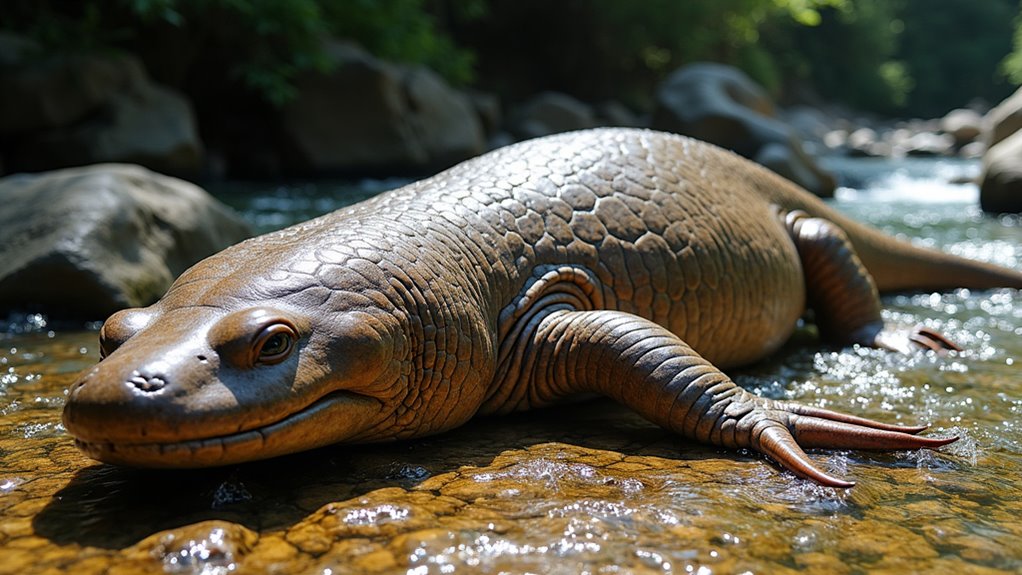
While green anacondas dominate as massive reptiles, giant Chinese salamanders reign as the undisputed titans of the amphibian world. These “living fossils” have existed for over 170 million years and can grow to human size—reaching nearly 6 feet long and weighing up to 110 pounds.
You’ll find these critically endangered creatures exclusively in China’s Yangtze River basin, where they live fully aquatic lives in rocky streams. Despite poor eyesight, they’re effective nocturnal hunters using specialized sensory nodes to detect prey vibrations. In the wild, they face serious threats from illegal wildlife trade and are increasingly rare due to overexploitation for luxury food markets.
You’ve now explored nine of Earth’s most impressive giants. As you’re learning about blue whales dwarfing dinosaurs, it’s worth noting that you’ll never encounter most of these creatures in your daily life. Yet remarkably, they share our planet at this exact moment in time. Understanding these massive species helps you appreciate Earth’s incredible biodiversity and the importance of conservation efforts to protect these magnificent animals.